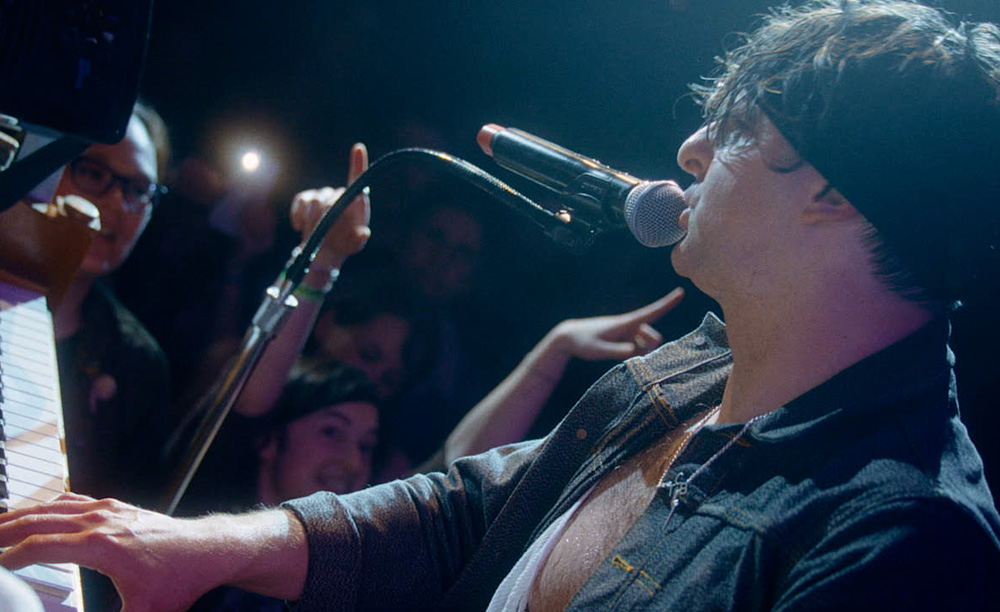“Playing to 10 people is harder than playing to 10,000, and if you can cut through the awkwardness you’ve done your job,” says Adam Weiner in his capacity as the lead singer for Low Cut Connie, a band out of Philadelphia that makes its primary business concern to give audiences a good time. Weiner had wanted to make noise when he started the band, but not in the way that many acts end up where music becomes merely a means to chasing fame and fortune, content to blow the roof off small clubs when he himself started out playing Tina Turner covers at a drag karaoke bar and eventually started writing songs of his own.
When Weiner and his Low Cut Connie crew make their way to New York in the raucous concert film “Art Dealers,” it isn’t to play Madison Square Garden but the cozier confines of The Blue Note where the band rocks out but honors the spirit of the legendary jazz club when freestyle improvisation keeps everybody on their toes. For a band that Weiner calls “an accidental birth,” it’s nearly bar mitzvah age when Weiner and Roy Power capture a live performance for posterity and allow audiences everywhere to join in the dance party, perhaps not having the marketing team to fill an arena, but definitely having the sound to reach all the way back to the rafters. Moving like a freight train, the film shows Low Cut Connie powering through a set as you come to learn how the band came together and have made an impact beyond the stage, playing a benefit show in Pittsburgh after the mass shooting at the Tree of Life Synagogue in 2018 and bringing some much needed joy following the pandemic after inching their way back on the road.
With the film now capping off a month-long theatrical tour across the country with a Los Angeles grandstand this week before arriving on VOD, Weiner and Power, who makes his feature debut on the film after previously teaming with Low Cut Connie on some music videos, spoke about bringing the band to the big screen in “Art Dealers,” giving themselves the same risk as fans that might miss out on the show by making it a one night only event to film, and how it became an unexpected portrait of the values that Weiner holds dear as both a performer and as a person.
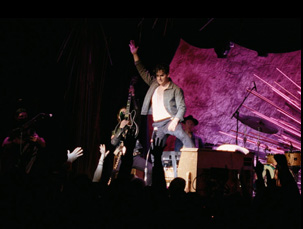
Roy Power: Back in 2016, I started working video production and I was just a young kid, maybe 22 and I just discovered Low Cut Connie. So I’m like, “Hey, you guys want to make a music video?” And we made a few and Adam and I have talked on and off a lot through the years about movies and music. So the time just came right after the pandemic where we decided that we both really wanted to make a concert movie and he called me up and I said yes right away. And the next few years, my life was dedicated to this project.
Adam Weiner: Well, I didn’t give him a choice.
Roy Power: He held me a gunpoint.
From his description, it sounds like you may have corrupted him a bit, starting out as a young kid and all…
Adam Weiner: You know what? They call our band the Sultans of Sleaze, so I’ve been accused of worse.
From what I understand, Adam may have had the idea before the pandemic. How did this evolve?
Adam Weiner: During the pandemic, we didn’t know if there was going to be a touring industry at all and the world just seemed to change so much. We had spent 10 years doing these beautiful, magical shows, and we’d never really captured them and I thought, “Man, maybe it’s all over.” When we came back, I didn’t know if we’d have an audience or if the audience would be too jaded or depressed coming out of the pandemic to have the same kind of energy that we used to have at our shows. But we did a couple shows with masks and social distancing and above the masks, I could see people weeping at those first couple shows that we did, which for a fun, wild rock and roll show, it was odd to see people so emotional. I realized that that was the exact moment that we had to make a film right then — the moment of reentering community where people first start to touch each other again and start to feel joy again, first start to process their traumas and their emotions through music. That moment was what I wanted to capture, so we had to turn it around pretty quickly and shoot this right when we first did our non-mask shows, which was the beginning of 2022.
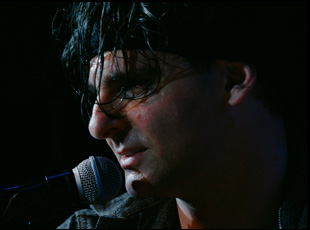
Adam Weiner: We didn’t have options. We had to do it in one night. There are some amazing concert films that we really adore, the top of the tree being “Stop Making Sense” by Talking Heads. Their approach was to do three nights of the same show that was very well-rehearsed [with] the lighting and the sound and all the cues, everything very choreographed. They knew they had full coverage for every song, every moment. But that’s not in the spirit of Low Cut Connie, where everything we do is pretty unplanned, pretty wild and very unpredictable. Roy had the unenviable task of trying to corral the circus, trying to capture this eight arm octopus of our show and get it in one. And if we got the show, we’d have a movie. And if we didn’t, then we would be wasting our time.
Roy Power: And on top of that, we really didn’t want to play it safe either. When you typically only have one night to do something, you’re going to want to set up one wide camera here, one wide camera here and keep it steady because you don’t want to miss anything. But with this, it was a lot more loosey goosey. We just went out and said, “Fuck it. Let’s try and try and get everything we can and do weird zooms and creep around the stage.” It made the editing process a lot tougher, but the movie a lot more interesting.
You also get a real feel for the physicality of the show. There’s some still photography in there as well as all the different kinds of camerawork that gives it all these different textures. What was it like to get the right mix?
Adam Weiner: With the theme of the film, I want people to be aware of how these images are being made. We’re showing the grit and grime of how we put a show together and all that goes into it, so I wanted people to be able to see the craft and the choices of the image making that we were doing. We did a bunch of different things and one of them that you can see in the film is we had a still photographer who wore a GoPro on her head and she was shooting with a flash all night. We got all this grainy GoPro footage and then you see the flash and then you’d see these amazing images that she was creating because I wanted the audience in a subconscious way to look through the eyes of the artist, so in this case, she’s looking at a mess and she pulls out an iconic image out of that mess in a split second. I wanted people to see that process.
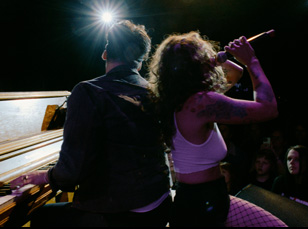
Adam Weiner: Not really. I handed the steering wheel to Roy and then I had to go be me and do my job, entertaining the people that are in front of me. I didn’t think about making a movie at all. I wasn’t playing to the camera. I wasn’t mindful of if there was a camera behind me when I stick my leg out. If they get kicked, they get kicked. It was Roy’s job to capture it. I just had to entertain those four or five hundred people that were in front of me and give them this absolutely cathartic experience. As far as a set list, I plan to a degree, but I have to shoot from the hip because you never know until you walk out on stage with that particular group on that particular night in that particular club is going to want and need. Maybe they need to laugh. Maybe they need something serious. Maybe they need something crazy and I need to be able to pivot moment to moment so I don’t get too married to a set list.
Roy Power: Right, and [it was a lot like] Martin Scorsese’s movie of the Rolling Stones, “Shine a Light.” The first 20 minutes that movie is Scorsese begging Mick Jagger, “Give me the set list!” I was doing the same thing with Adam, but it didn’t matter. It’s better that I didn’t know the set list and the camera operators didn’t know and just go with the flow, just like the band does.
What was it like to find the structure in the edit? You do get around to introducing everyone in the band and sharing a little bit of its history without straying too far from the concert.
Roy Power: That was the most fun part for me, just pulling and pushing and pulling different ideas and moving songs around with Adam and Paul, our editor. What I think is the most interesting thing is how each individual seems to be edited with a very different rhythm than the previous one and subconsciously I think that’s what keeps people’s attention going. But on top of that, these little behind the scenes vignettes with the rest of the band that pop in not only provide good context about the band, but it grabs people when they start to get bored of hearing a song. [So it’s like] “Oh, here’s Abigail on roller skates. Here’s another song. Here’s Rocky at a dive bar.” And it’s got this energetic rhythm that keeps it going.
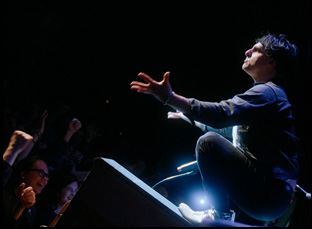
Adam Weiner: I wanted to show what it is to be a working class artist in America. We see all these films from the top one percent of pop stars, putting their arena shows together or navigating pop life, as Prince said. Some of those films are good, but it gives a very narrow image of what it is to be an artist these days. And for those of us down here, scrapping it out in clubs and theaters and dive bars, we do it for different reasons. There are so many artists out there — filmmakers, choreographers, dancers, writers, musicians — who live for their art and they are not necessarily motivated by fame or fortune. It’s not an easy life, so even though the show we put on is fabulous in a way, what goes into making it and what has gone into sustaining it is not. And I did want to show that and I wanted to perhaps maybe inspire one artist out there who’s thinking about this life and maybe show them a way to do it that isn’t just trying to become a pop star.
It was also quite interesting to see your connection to Judaism explored in the film without being didactic. Was that tricky to figure out how to incorporate or even obvious to include in the first place?
Adam Weiner: It’s something that the world has reflected back to me over the years. It’s not something I used to think about much when I was younger, but traveling the world as a Jewish performer, the world has reminded me over and over in different situations that I am a Jew. And in some ways, during the pandemic, when I was doing my live stream series and speaking to people on camera every day like this [on Zoom], what I call my Jewiness really came through — my gallows humor especially, but also this perseverance and resilience and sense that bad things are going to happen and they’re going to happen all the time. You have to expect them, but we have to move on. We have to keep pushing forward. And I’ve come to understand my own Jewish heritage and culture more through my music, even though I’m an atheist and I don’t really have a spiritual practice. My art is my spiritual practice, but I think I have a very Jewish outlook in how I look at the world and I wanted people to see it in the film.
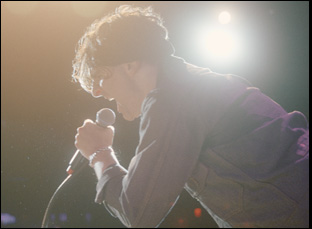
Adam Weiner: So sweet. We made this film and I certainly didn’t expect it to play in a theatrical run or be released on demand. When I make an album, I don’t think about how it’s going to be released or are people going to hear it? I’m just making something that I think is great. So we made a great piece of entertainment and then the fact that it’s gotten picked up and we get to go across the country with all these screenings and see people’s faces during the screening and after and how all different people, all ages, backgrounds are connecting with it in different ways, from artists who see a piece of themselves in it, young people, queer people, Jewish people, it’s really been an amazing experience.
Roy Power: It’s pretty awesome. I agree with every word Adam said. It’s surreal. You never expect something like this to get into more than a couple of film festivals and then get dumped online. But we’ve gotten to tour so many great theaters across the country — places I’ve never known existed, but are the best movie theaters I’ve been to. In Austin, we were at AFS Cinema, which was founded by Richard Linklater and it was cool to be able to see some of my favorite movies — “Paris, Texas,” “The King of Comedy,” and then watch “Art Dealers” on the same screen. Going to Portland two nights ago, [we had] one of the coolest marquees ever, Cinema 21 with “Art Dealers” right there in big print. It’s pretty crazy to see. I hope it gets to happen again sometime soon.
“Art Dealers” will open in Los Angeles on September 27th at the Lumiere Music Hall, starting off with a special opening night screening at 8 pm followed by a live performance from Low Cut Connie. The film will be released on VOD on October 1st.




